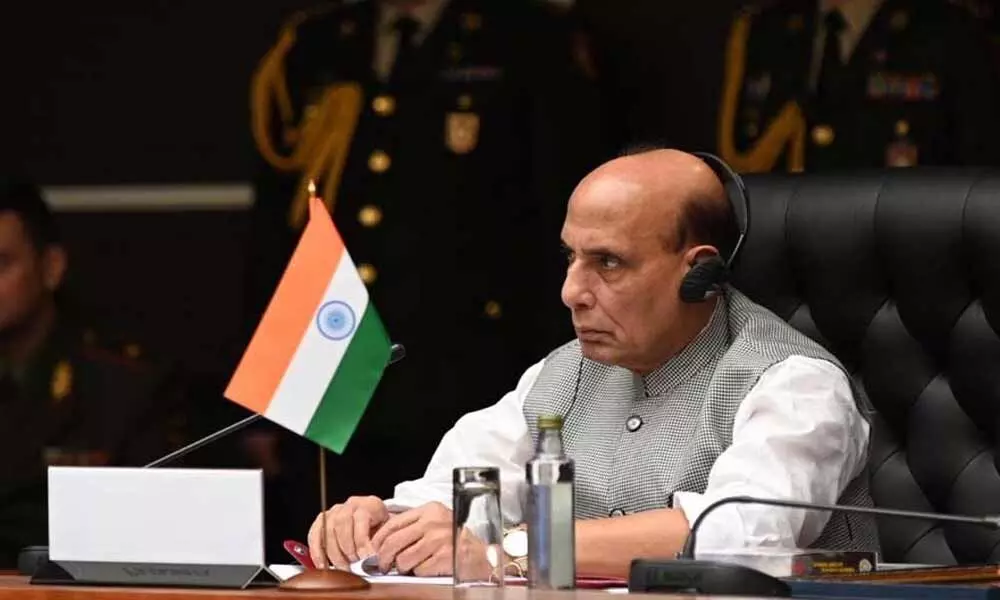China in illegal occupation of 38,000 sq km of Indian land: Rajnath

Union Defence Minister Rajnath Singh (File/Photo)
China is in illegal occupation of 38,000 square km of Indian land and it considers another 90,000 square km as its own, Union Defence Minister Rajnath Singh said
New Delhi: China is in illegal occupation of 38,000 square km of Indian land and it considers another 90,000 square km as its own, Union Defence Minister Rajnath Singh said in Parliament on Tuesday, adding that the Line of Actual Control (LAC) is not clearly delineated.
The Defence Minister said that China has tried to disrupt the ground situation in May and June and it led to India's response. "We have told China that such incidents won't be acceptable to us," Rajnath said.
China continues to be in illegal occupation of approximately 38,000 sq km in the Union Territory of Ladakh. In addition, under the so-called Sino-Pakistan 'Boundary Agreement' of 1963, Pakistan illegally ceded 5,180 sq km of Indian territory in Pakistan-occupied Kashmir to China. China also claims approximately 90,000 sq kms of Indian territory in the eastern sector of the India-China boundary in Arunachal Pradesh, the minister said.
China does not accept the customary and traditional alignment of the boundary between India and China.
"We believe that this alignment is based on well-established geographical principles confirmed by treaties and agreements, as well as historical usage and practice, well-known for centuries to both sides," the minister said.
The two countries had engaged in discussions during the 1950s and 60s but these efforts could not yield a mutually acceptable solution.
Both India and China have formally agreed that the boundary question is a complex issue which requires patience and have committed to seeking a fair, reasonable and mutually acceptable solution through dialogue and peaceful negotiations.
In the interim, the two sides also agree that maintenance of peace and tranquillity in the border areas is an essential basis for the further development of bilateral relations.
The Defence Minister said as yet there is no commonly delineated Line of Actual Control in the border areas between India and China and there is no common perception of the entire LAC.
Therefore, in order to ensure peace and tranquillity in the border areas, especially along the LAC, the two countries have concluded a number of agreements and protocols.
Under these agreements, the two sides have agreed to maintain peace and tranquillity along the LAC without prejudice to their respective positions on the alignment of the LAC as well as on the boundary question.
"It is on this basis, that our overall relations also saw considerable progress since 1988. India's position is that while bilateral relations can continue to develop in parallel with discussions on resolving the boundary question, any serious disturbance in peace and tranquillity along the LAC in the border areas is bound to have implications for the positive direction of our ties."
A key element of both the 1993 and the 1996 agreements is that the two sides will keep their military forces in the areas along the Line of Actual Control to a minimum level.
These agreements also mandate that pending an ultimate solution to the boundary question, the two sides shall strictly respect and observe the Line of Actual Control.
Furthermore in these agreements, India and China also committed to clarification and confirmation of the Line of Actual Control to reach a common understanding of the alignment. Thus, in late 1990s and upto 2003, the two sides engaged in an exercise to clarify and confirm the LAC.
But, thereafter the Chinese side did not show a willingness to pursue the LAC clarification exercise. As a result, there are some areas where the Chinese and Indian perceptions of LAC overlap.
In these areas, as also with other sections of the border areas, the various agreements govern the manner in which troops of both sides should operate and deal with situations of face-offs to maintain peace and tranquillity.
Since April, India had noticed a buildup of troops and armaments by the Chinese side in the border areas adjacent to eastern Ladakh.
"In early May, the Chinese side had taken action to hinder the normal, traditional patrolling pattern of our troops in the Galwan Valley area, which resulted in a face-off," Rajnath said.
Even as this situation was being addressed by the Ground Commanders as per the provisions of our bilateral agreements and protocol, in mid-May the Chinese side made several attempts to transgress the LAC in other parts of the western sector, he said.
This included Kongka La, Gogra and North Bank of Pangong Lake. "These attempts were detected early and consequently responded to appropriately by our armed forces," said the minister adding, "We made it clear to the Chinese side both through diplomatic and military channels that China was, by such actions, attempting to unilaterally alter the status quo. It was categorically conveyed that this was unacceptable."
Given the growing friction along the LAC, the senior commanders of the two sides in a meeting on June 6, 2020 agreed on a process of disengagement that involved reciprocal actions.
Both sides also agreed to respect and abide by the LAC and not undertake any activity to alter the status quo. However in violation of this the Chinese side created a violent face-off on June 15 at Galwan. "Our brave soldiers laid down their lives and also inflicted costs including casualties on the Chinese side," the minister said.
He also said that the conduct of Indian armed forces throughout these incidents shows that while they maintained "Sayyam" (patience) in the face of provocative actions, they also equally displayed "Shaurya" (valour) when required to protect the territorial integrity of India.
He said India believes that mutual respect and mutual sensitivity are the basis for peaceful relations with neighbours."
"As we want to resolve the current situation through dialogue, we have maintained diplomatic and military engagement with the Chinese side," the minister said.
"In these discussions, India has maintained the three key principles that determine our approach that is both sides should strictly respect and observe the LAC, neither side should attempt to alter the status quo unilaterally and all agreements and understandings between the two sides much be fully abided by in their entirety."
The Chinese side, on its part, took the position that the situation should be handled in a responsible manner and ensure peace and tranquillity as per bilateral agreements and protocol.
Even as these discussions were going on, the Chinese side again engaged in provocative military manoeuvers on the night of August 29 and August 30 in an attempt to change the status quo in the South Bank area of Pangong Lake.
But yet again, timely and firm actions by our armed forces along the LAC prevented such attempts from succeeding.
"As is clear from these events, the Chinese actions reflect a disregard of our various bilateral agreements," the minister said.
The amassing of troops by China goes against the 1993 and 1996 agreements.
Respecting and strictly observing the LAC is the basis for peace and tranquillity in the border areas and is explicitly recognised in both 1993 and 1996 agreements.
"While our armed forces abide scrupulously by it, this has not been reciprocated by the Chinese side," the minister said. Their actions have led to face-offs and frictions from time to time along the LAC.















